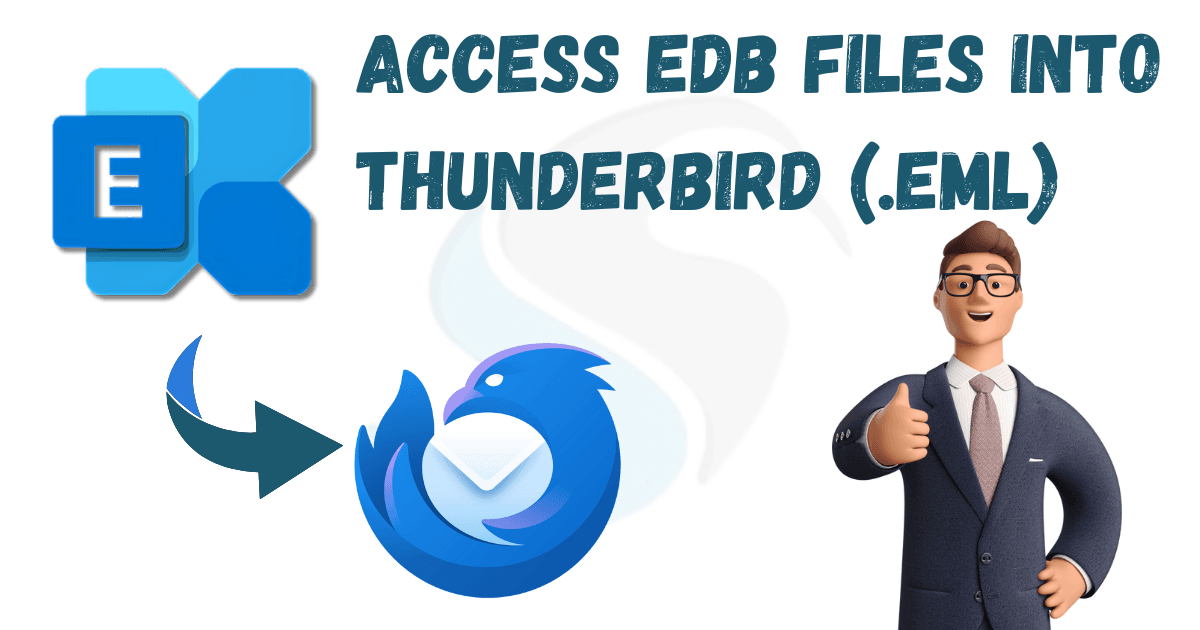Summary: In this blog, we discussed the best ways to Access EDB files in Thunderbird (.eml) file format via the Manual Method or professional approach. We will also address the reasons why users export EDB files into Thunderbird(.eml). Let’s start with the methods.
Overview of EDB files
The format by which Microsoft Exchange Server stores its mailbox data consisting of emails, contacts, calendars, and many others is called EDB or Exchange Database. It is a proprietary format that has been exclusively created for use in the Microsoft Exchange Server platform to properly manage and keep well-organized the email data of its users.
Why Users Want to Access EDB Files into Thunderbird (.eml)
- Cost & Licensing: Many businesses move from Microsoft Exchange to open-source email clients such as Mozilla Thunderbird to save money on Exchange and Outlook licenses.
- No Exchange Server Access: If a user no longer has access to an Exchange Server but has a backup of EDB files, converting them to an EML format allows them to view their email data in Thunderbird.
- Email Backup and Archiving: Some users and administrators prefer to convert EDB files to EML in order to generate conveniently accessible email archives. EML files can be saved individually, making them easier to maintain and transfer between platforms.
- Thunderbird is cross-platform: it operates on Windows, macOS, and Linux, allowing users to view their emails from several operating systems. If emails are converted from EDB to EML, users can move their email archives and operate with them on multiple platforms without being limited to the Microsoft ecosystem.
How to Export EDB Emails to EML via the Exchange Web Services (EWS) API and a PowerShell Script.
Exchange Management Shell does not natively support directly exporting EDB emails to EML format in Exchange Server since PowerShell cmdlets such as New-MailboxExportRequest only allow exporting to PST, not EML. However, there are ways to accomplish this using Exchange Web Services (EWS), PowerShell scripting, or third-party solutions.
Below, I’ll show you how to use Exchange Management Shell to export EDB to EML format using a third-party utility.
Step 1: Prerequisites.
- Exchange Servers: The approach presupposes you have access to the Exchange Server environment where the EDB file is located.
- EWS Managed API: You must download and install the EWS Managed API if you intend to use scripting.
- PowerShell Scripting Knowledge: Emails can be exported using a PowerShell script that interfaces with Amazon Web Services (AWS) as the standard New-MailboxExportRequest cmdlet does not handle EML exports.
Step 2: Download and Install EWS Managed API.
You can download the EWS Managed API from Microsoft’s official website, or skip this step if you already have it installed on your server.
- Download the EWS Managed API.
- Install the API on your Exchange server.
Step 3: Create a PowerShell script for EWS Export to EML.
The PowerShell script below uses EWS to connect to an Exchange mailbox, retrieve emails, and save them in EML format.
Explanation:
- The EWS Managed API is used to communicate with the Exchange mailbox and retrieve emails.
- The script connects to the user’s mailbox using their credentials.
- Emails are fetched from the Inbox (or other folder) and exported to EML format via the MimeContent attribute.
- Emails are saved in the given folder (C:Emails).
Step 4: Run the Script.
- Run the script in PowerShell after updating it with the necessary credentials (replace mailto:user@domain.com with the appropriate path locations).
- The script will go over all emails in the provided folder and export them to EML format.
Step 5: Verify the Exported EML files.
Once the script is finished, go to the folder where you exported the emails and ensure that the EML files were saved appropriately.
After saving EML files, you can import them into Mozilla Thunderbird and access your EDB files in Thunderbird.
Drawbacks of the Manual Method
- Time-Consuming and Complexity of Steps
- Risk of EDB files Corruption
- Not useful for offline or orphaned EDB files, etc
Automated Way to Export EDB to Thunderbird (.eml)
After reading and knowing the drawbacks of the Manual Method, you can use a specialized tool like Softaken EDB to PST Converter Software. This application allows you to easily convert your Exchange EDB files into Thunderbird (.eml) format. It also converts EDB files to PST, MSG, HTML, vCard, etc.
Simple Steps to Use EDB to PST Converter Software
- First, install and execute the EDB to PST Converter on your computer.
- After that, use the provided window to browse the Exchange EDB and STM files.
- Next, select the Exchange Server version of the EDB file from the drop-down list.
- The Preview Panel allows the previewing of the EDB file selected.
- Then, select EML as the file format and hit Save to Path to navigate to the chosen location.
- Next, select the advanced option to take advantage of the software’s unique features.
- Finally, save the file to export EDB as an EML file.
Conclusion
Now, it is up to which method or technique you choose for your technical expertise. We have mentioned both a manual and an alternative program. The method was associated with lots of drawbacks so most technical proficient users recommended using specialist utility.
Read also Easiest Way to Convert Outlook PST to EML File in Bulk




